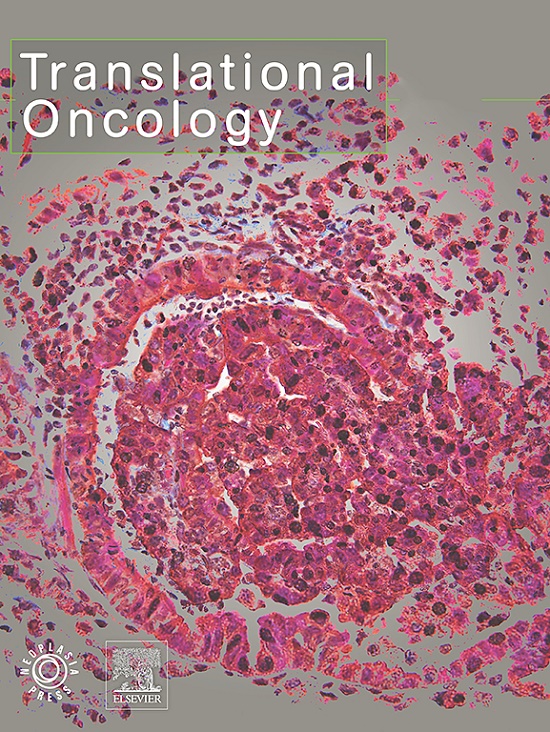miR-4537通过靶向肾细胞癌中的MIOX抑制铁下垂
IF 5
2区 医学
Q2 Medicine
引用次数: 0
摘要
铁凋亡是一种铁依赖性的细胞死亡模式,因其在各种癌症,特别是透明细胞肾癌(ccRCC)的进展中的关键作用而受到关注。然而,铁下垂与ccRCC之间的复杂关系在很大程度上仍未明确。本研究旨在通过检测TCGA ccRCC数据库中鉴定的差异表达基因(DEGs)和ferdb数据库中编目录的铁下垂驱动基因(致力于铁下垂调节因子和铁下垂-疾病关联)来剖析铁下垂对ccRCC的贡献。我们利用786-O和ACHN ccRCC细胞系,以及HK2(人肾-2)细胞和HKC(人肾细胞),证实了9个共享基因的表达。其中,与HK2和HKC细胞相比,MIOX(肌醇加氧酶)在ccRCC细胞中显著下调。随后的生存分析揭示了MIOX表达与患者生存改善之间的正相关,强调了其预后意义。对MIOX调控的进一步研究通过TargetScan预测确定了四种mirna,其中miR-4537在ccRCC细胞系中显著上调。涉及miR-4537模拟物和抑制剂,结合铁下垂诱导物和抑制剂的功能分析,阐明了其对ccRCC细胞生长和铁下垂调节的影响。结果显示,诱导铁下垂后miR-4537表达降低,miR-4537抑制剂通过促进铁下垂显著抑制ccRCC细胞增殖,而模拟物则发挥相反的作用。在机制上,miR-4537靶向MIOX的3 ' -UTR调控其表达,最终抑制ccRCC细胞中的铁凋亡。我们的研究表明,miR-4537通过调节ccRCC中的MIOX抑制铁下垂,为铁下垂在癌症生物学中的机制提供了新的见解,并突出了通过铁下垂调节治疗癌症的潜在治疗途径。本文章由计算机程序翻译,如有差异,请以英文原文为准。

miR-4537 curtails ferroptosis by targeting MIOX in renal cell carcinoma
Ferroptosis, an iron-dependent mode of cell death, has gained prominence for its critical role in the advancement of various cancers, notably clear cell renal carcinoma (ccRCC). The intricacies of ferroptosis’s involvement in ccRCC, however, remain largely undefined. This study aimed to dissect the contribution of ferroptosis to ccRCC by examining differentially expressed genes (DEGs) identified within the TCGA ccRCC database and ferroptosis driver genes catalogued in the FerrDb database (dedicates to ferroptosis regulators and ferroptosis-disease associations). We employed 786-O and ACHN ccRCC cell lines, alongside HK2 (human kidey-2) cells and HKC (human kidney cells), to confirm the expression of 9 shared genes. Among these, MIOX (myo-inositol oxygenase) emerged as significantly downregulated in ccRCC cells compared to HK2 and HKC cells. Subsequent survival analysis illuminated a positive correlation between MIOX expression and improved patient survival, underscoring its prognostic significance. Further investigations into MIOX regulation identified four miRNAs via TargetScan predictions, with miR-4537 significantly upregulated in ccRCC cell lines. Functional assays involving miR-4537 mimics and inhibitors, combined with ferroptosis inducers and inhibitors, elucidated its impact on ccRCC cell growth and ferroptosis modulation. The results revealed that miR-4537 expression was diminished following ferroptosis induction, and the miR-4537 inhibitor markedly curbing ccRCC cell proliferation by fostering ferroptosis, while the mimic exerted opposite effects. Mechanistically, miR-4537 targets the 3′-UTR of MIOX to manipulate its expression, ultimately inhibiting ferroptosis in ccRCC cells. Our research indicated that miR-4537 restrained ferroptosis by regulating MIOX in ccRCC, offering novel insights into the mechanisms of ferroptosis in cancer biology and highlighting latent therapeutic avenues for cancer treatment through ferroptosis modulation.
求助全文
通过发布文献求助,成功后即可免费获取论文全文。
去求助
来源期刊

Translational Oncology
ONCOLOGY-
CiteScore
8.40
自引率
2.00%
发文量
314
审稿时长
54 days
期刊介绍:
Translational Oncology publishes the results of novel research investigations which bridge the laboratory and clinical settings including risk assessment, cellular and molecular characterization, prevention, detection, diagnosis and treatment of human cancers with the overall goal of improving the clinical care of oncology patients. Translational Oncology will publish laboratory studies of novel therapeutic interventions as well as clinical trials which evaluate new treatment paradigms for cancer. Peer reviewed manuscript types include Original Reports, Reviews and Editorials.
 求助内容:
求助内容: 应助结果提醒方式:
应助结果提醒方式:


